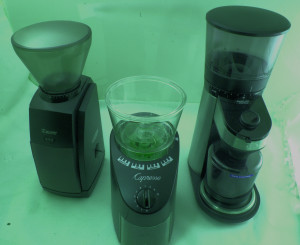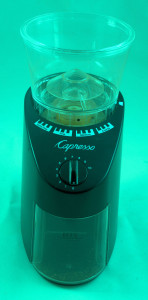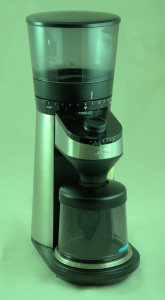 The missing mystery element in brewing is the grinder. There. I said it. Just like every heart doctor wonders if their newly released open-heart patient will exercise, every priest wonders if the just-forgiven sinner will truly repent and change their lifestyle, the coffee roaster must wonder how you’ll grind their beautiful fresh beans before brewing. To accomplish this you must have a good grinder. The word ‘good’ means it can effectively divide the bean into evenly-sized close-to-the-same-shape particles, and be as free as possible of the powdered particles the industry calls “pan”.
The missing mystery element in brewing is the grinder. There. I said it. Just like every heart doctor wonders if their newly released open-heart patient will exercise, every priest wonders if the just-forgiven sinner will truly repent and change their lifestyle, the coffee roaster must wonder how you’ll grind their beautiful fresh beans before brewing. To accomplish this you must have a good grinder. The word ‘good’ means it can effectively divide the bean into evenly-sized close-to-the-same-shape particles, and be as free as possible of the powdered particles the industry calls “pan”.
I often say that you can make excellent coffee using a simple Melitta manual drip cone, which retails (with a ceramic mug) for around $10. But, a grinder, now that’s a different story. Grinders at the lowest price end simply don’t perform well enough to be a fully functioning member of Team Coffee Brewing. Why is this? Let’s take it away from coffee to explain. If you’re making a stir fry, you know you must strive to consistently cut the vegetables. The reason you want them the same size is the heat will affect them evenly if they are. You’ll get cooked, crunchy vegetables. If they aren’t evenly sized, extremely large pieces won’t cook through and small ones will be overcooked.
In ideal coffee grinding, the pieces will also be the same size. This is necessary because contact time is identical for all those pieces. Larger pieces cause waste; you are not getting all their flavor; too small pieces will be over-extracted and dreaded bitterness occurs. The best grinders are produce grind size uniformity. The worst performing grinders are blade grinders. It is impossible to expect otherwise, as the blade is spinning and the beans are repeatedly and randomly struck. To expect any kind of uniformity is to expect order from chaos. Most readers here are not surprised at anything I’ve so far said, so let’s get going into examining these three grinders. They are all known as entry level, meaning they are lost-cost, but they are from well-regarded manufacturers serving the specialty coffee market.
 Capresso Infinity 560 Stainless Steel Conical Burr Grinder $99 The first one is from Capresso. Capresso actually has a long history in this product category. Started in the 1990s by Michael Kramm, an ex-Krups executive and now retired, Capresso went around and scooped up ex-Krups vendors and created some new and innovative products. Some are excellent and others are, in my opinion, okay but nothing special. This grinder was recommended to me by Michael himself, who while no longer working at Capresso, apparently still follows them and thought highly of it. I requested a sample and have been using it quite a while before being able to test it.
Capresso Infinity 560 Stainless Steel Conical Burr Grinder $99 The first one is from Capresso. Capresso actually has a long history in this product category. Started in the 1990s by Michael Kramm, an ex-Krups executive and now retired, Capresso went around and scooped up ex-Krups vendors and created some new and innovative products. Some are excellent and others are, in my opinion, okay but nothing special. This grinder was recommended to me by Michael himself, who while no longer working at Capresso, apparently still follows them and thought highly of it. I requested a sample and have been using it quite a while before being able to test it.
NOTE: There are two very similar Capresso grinder products. What differentiates them is the burr material, which does the actual grinding. One is ceramic. The other stainless steel. My industry contacts have told me that stainless is generally acknowledged to grind more consistently at coarser (medium drip through French Press) grinds. I asked for Capresso’s stainless steel grinder.
 Baratza Encore Conical Burr Grinder $129 The second model is from Baratza. Baratza practically owns the grinder market in the specialty world. Industry regard for their products is high enough that many shops use their costlier grinders, even though they are clearly aimed at consumers. While I’ve always assumed Baratza makes their grinders, I’ve noticed multiple countries of origin credited on their products. Do they really have multiple plants, or are they outsourcing? The model I tested is made in Taiwan, and uses a different burr set from the pricier Virtuoso models. However, Baratza is the leader and I was half expecting it to shame both the others, based upon their company’s reputation.
Baratza Encore Conical Burr Grinder $129 The second model is from Baratza. Baratza practically owns the grinder market in the specialty world. Industry regard for their products is high enough that many shops use their costlier grinders, even though they are clearly aimed at consumers. While I’ve always assumed Baratza makes their grinders, I’ve noticed multiple countries of origin credited on their products. Do they really have multiple plants, or are they outsourcing? The model I tested is made in Taiwan, and uses a different burr set from the pricier Virtuoso models. However, Baratza is the leader and I was half expecting it to shame both the others, based upon their company’s reputation.
OXO ON Conical Burr Grinder $199 The final model I tested is from the new kid on the coffee gear block, but one you’ve no doubt heard of in their other categories: OXO makes those soft-handled kitchen gadgets that populate the kitchen hand tools section at Bed, Bath and Beyond. Suffice it to say I was more than a little surprised when I spied OXO at last year’s International Housewares Show brandishing prototypes for both coffee brewers and a grinder! Before these tests I had no impression of OXO’s design or manufacturing prowess. I owned but a single product of theirs; a non-powered can opener. Needless to say I was eager to test their first grinder.
 Features compared All three of these grinders are more similar than dissimilar. They all feature simple overhead bins where beans can be stored and twist gauges to adjust fineness. The OXO grinder has one feature that is unique, even when compared to many costlier grinders than the others in this survey; An onboard scale.
Features compared All three of these grinders are more similar than dissimilar. They all feature simple overhead bins where beans can be stored and twist gauges to adjust fineness. The OXO grinder has one feature that is unique, even when compared to many costlier grinders than the others in this survey; An onboard scale.
Build quality and feel Again all three are similar, in that I could not predict which if any would fall apart or lose its ability to meet specifications by a certain date. If I were to nitpick, I’d suggest the Capresso had a slightly ‘plastic’ feel to it, but I’m not at all sure that another tester would feel the same way. Might be my taste. This is good news because it makes it simple to compare and decide for the right reason: which one grinds coffee the best!
Grind tests I brought all three to Modern Process. Modern Process makes many of the world’s industrial grinders. Name a large roasting plant that packages pre-ground coffee and I bet you they use grinders from this company. I’ve known Dan Ephraim, their CEO since I first wished to write about coffee. He was literally the first industry person I met. We are friends and he and his tester, Rasmy, conducted several tests with each grinder, using beans from Euro Coffee in Los Angeles. Then, each sample was place in a ro-tap device. In case you’re new to testing grinders, this device is a series of screens. The idea is to analyze what percentage of grounds are what size, so we can compare grinders to a theoretically perfect standard and also between each other. The best grinder is going to be one that has the largest majority of grinds that are the ideal size, with smaller percentages of smaller and larger sized ones. We set each grinder for what we all agreed by eye was a drip grind. The best grinder in this test was the Capresso. But, just as significantly, the others were darn close.
Conclusion I could live with any of these three grinders. They are all good choices. I was surprised at how similar, rather than different they performed. Baratza has done a good job with their entry level grinder, but it is not superior to either of the others. The OXO has the very useful scale feature, which will be a deciding factor for some, and helps simplify the measuring process, where many mistakes are made, so it is fairly associated with quality. Capresso leads the pack in both grind quality and price. Considering I’ve owned it the longest and used it quite a bit, it’s already proven its longevity and value. Just a few years ago, coffee enthusiasts would justly complain that there were few grinder options for the less well-heeled. Thanks in part to these three brands, this is no longer the case.
#Capresso


Nice review. Concise, fun and to the point. Great read.
Thank you, Orrin. It was a joy to discover good quality, affordable grinders.
Hey Kevin,
Glad to see a new post! I owned a Virtuoso for several years and have heard nothing but great things about the Capresso and the Baratza, with more people seeming to go for the Baratza these days.
I was under the impression that all US sold Baratza’s were made in Taiwan, but the refurbished models they sell on their website are rebuilt at their facility in Bellevue, WA. I also know that at least the Vario is sold as a Mahlkonig in Europe (it uses Mahlkonig burrs).
From all of my forum reading I see a lot of people opting for one of the Breville grinders as well. If you ever get a chance to use the ro-tap again I recommend bringing one of those along.
Not for everyone, but I’ve sold all of my electric grinders, I use an hg-1 for espresso and a Lido 3 for everything else. I think the Lido rivals the grind quality of grinders many times it’s price.
You might also be interested in following the experiments of Socratic Coffee in Australia, they’re using a ro-tap or something similar to measure the consistency of a lot of different grinders and publishing the data on instagram and on their website.
Have a good one!
-Alex
Kevin
Good review.
How do these compare to the next level up? For example, is the Baratza Virtuoso both more reliable and does it produce grind of significantly better consistency to warrant the extra money spent. I pushed the Virtuoso as a point of comparison because, if I remember correctly you are familiar with that grinder. Also it seems to be at a price point that one might also consider, without being that much more costly.
Again, thanks for the review.
Jay
Hi Jay,
The quick answer is Baratza makes no claims that the Virtuoso and Encore share the same burr. The Virtuoso and the Preciso do. Until I know better, I would suggest the way to save money is to buy the Virtuoso instead of the Preciso if you’re doing non-espresso brewing. I’m not confident of my memory from my previous Baratza test, done at least two years ago. The three machines in this test did quite well. I’m pretty sure you’d be happy with any of them.
Kevin
I only brew with the Ottomatuc. Coarse grind as per your suggestion.
Thanks
Jay
Hi Jay,
If you can stretch, the best of the bunch is the Preciso. While it has the same burr as the Virtuoso, the Preciso’s grind settings allow finer tuning. That said, you could get lucky with the Virtuoso. It certainly will be close. Both do a great coarse grind.
Hi Kevin
I am really liking my Baratza Virtuoso. When I grind coarse for Chemex (28-30) I find myself using more coffee than to 10 grams per six ounces of water. That would be 40 grams of coffee for 24 ounces of water. Instead, I am using about 48 grams of coffee for 24 ounces of water. I’m using the Ottomatic. Is more coffee to be expected when I use a “French Press” grind ? Should I be grinding finer or be using more coffee.
Thanks.
Jay
Dear Kevin
I had an epiphany recently about coffee brewing and am anxious to hear your thoughts. After reading thousands of webpages and viewing countless videos on coffee brewing (including your book and all your articles and videos) a simple idea hit me.
A good drip coffemaker like a Technivorm or Bonavita , cost aside, is a MUCH BETTER way to make coffee than any snobby manual method be it French Press, or Chemex or Hario dripper or Aeropress. Here’s why.
With a good machine you only need worry about grind size and recipe. Everything else will be perfect and consistent.
With any manual technique you must first boil water ,so time-wise its going to lose to any machine.
Secondly, you must now wait-how long?- till the water cools to under 205 but not by too much! Good luck!
Thirdly, you have to time yourself as you pour or wait to press.
Fourthly, your water is cooling as you progress, something that essentially doesnt happen with a good machine.
And fifthly, pouring technique needs to be done properly and is a time consuming pain.
So unless youve got time to spare, and talent, and dont mind variability, the drip machine is the clear winner I say. What says Coffee Kevin?
Hi Michael,
You’ve given us a lot to consider. I agree wholeheartedly with your basic contention. Looking at brewing as a scientific process, the best way to proceed is to be able to minimize variables as much as possible. I realize this also limits the variables that can be changed. For instance, the brewing temperature is preset in most automatic drip machines, even ones so well made as the Technivorm. As you correctly cite, the difficulty in manual methods is so there is so much flexibility, it is difficult to track all of the variables as we make succeeding batches. This is the reason I’ve limited my tests of automatic brewers to their ability to produced an industry-approved 200F water temperature and get it to travel through the grounds within the industry-approved 6 minutes (assuming drip grind), or something equal. It isn’t perfect, but it’s a baseline. I have often stated that in an ideal world, the brewers would be automatic ones – that is, ones that included all the processes in one unit. This includes grinding, by the way, and grinding is among the most difficult to include. So far, none of my favorite automatic drip makers includes one. Keep up the good work.
Warmly,
Kevin
Kevin
For a Chemex, should the coffee bed, after brewing, be flat or V shaped ?courser grinds , with my Ottomatic, yield a flatter coffee bed.
I want to also support the virtues of automated brewing. I was brewing manually with Chemex for years. I could never get consistent results. While. I could keep grind and coffee to water ratio constant, the very act of pouring and speed and scope of water dispersion and even temperature just varied to much each day.
BTW, I already have a Virtuoso. I was wondering what my next grinder might be.
Thanks
Jay
Hi Jay,
I’m not averse to shaking the grounds bed to be flat, but no more. We want it to lie flat but not to in any way be compacted. I actually met someone who used a tiny saucer as a tamper. That risks closing space the water needs to drip properly through the grounds bed.
Yes, automation is a wonderful thing, because it eliminates so many variables. There are trade-offs, but I keep saying that the future of coffee brewing long-term belongs to the best automated brewers. Chemex is to be credited as the company that, to my knowledge, was the very first to automate the brewing process into spaced pours, which is repeated in their Ottomatic.
Warmly,
Kevin
Kevin
Thanks for your response.
My question about the appearance of the coffee bed (flat vs V shape) related to what the brew bed looks like after brewing. Consequently, should the brew bed after brewing be flat?
Jay
I generally think flat.
Thanks Kevin
When grinding coarse for Chemex (French Press Grind), do I need to use more coffee than the recommended 10 grand per six ounces. I am tending toward more coffee. For 24 ounces of water , I am using 44-47 grams of coffee.
Jay
Hi Jay, I know there are diverse opinions on this. I buy just enough coffee to say you should not grind too coarse either. And, an indication you are grinding too coarse is having to use more than 10 grams per 6 ounces. To me, this is a maximum. If it’s not strong enough and you’re using this formula, I’d go a little finer.
Warmly,
Kevin
Thanks Kevin
I will try finer.
Jay
I have a Capresso Infinity grinder and the Bonavita BV1800 brewer. What exact grind setting do you recommend for this combo?
Hi Michael,
I want to warn everyone that grinders always have calibration variances that make any specific click recommendation risky. That said, I’d start with the coarsest of the “fine” settings. I’d move one notch at a time to get the taste you like.
Hope this helps.
Warmly,
Kevin
Hi Kevin,
What would you recommend for the amount of coffee in grams brewing 6 cups on the Bonavita BV1800? I can’t seem to dial in the grinder setting and amount of coffee!
I’m going to invest in a burr grinder (considering either the Capresso Infinity or the Baratza Encore). I found a lot of other reviews stating the Baratza is much better. But it looks like you’d lean toward the Capresso for drip coffee?
Thanks for all your great information!
Hi KJ,
I tend to make a full batch. I haven’t used this unit in a while but I recall it took about 60 grams to make a full batch. I’d try around 50 grams. As far as grinders, the Capresso and Baratza were very close in their tests, close enough that I’d consider both equals. As far as build quality, I suspect what’s under the hood is also close, but I do not have the capability to test component quality.
Warmly,
Kevin
I have to admit, I feel pretty silly now because I considered myself quite the coffee connoisseur yet I had no idea that the quality of the grinder you use had such a profound effect on the overall quality of the coffee. I’ve been using a less-than entry level (by this post’s standards, at least) grinder all this time… I think it’s time for an upgrade!
Kevin
You might want to check out the Breville Smart Grinder Pro. its grind range is more limited than Baratza at the coarse end (it’ does not grind as coarse at FP), but it has a number of advantages.
It has an easy to see LCD display. It does not dump grinds onto the counter (least messy grinder I have used) and within its narrower grind range, it is very very consistent. If fact, way more consistent than Baratza and Infinity grinders I have used. Grinder Cleanup and maintenance is super easy.
I recently read that grind size should be related to batch size for a drip machine. It said that for two cups use fine grind and for the full 8 cups batch use a medium grind (Bonavita recommends a coarser grind in their manual). It makes sense when you consider the shorter brew times of smaller batches. Yet, I have never read that anywhere else.
What do you think?
Hi Michael,
One of the challenges of drip is every time we change batch size, we’re changing shortening or lengthening contact time. One way of addressing this is to increase or decrease the grind size, and thus the surface area the water is in contact with. When done correctly, the coffee flavor strength remains the same. So, yes, if we’re doing something like a smaller batch, you can grind a notch finer, or if you’re making a full batch, you can go coarser. The challenge is discovering how much and it’s really trial and error.
Warmly,
Kevin